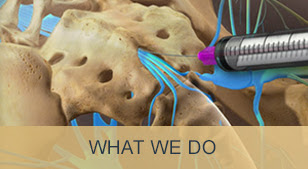Bursa & Joint Injections
The bursae are the small, fluid-filled sacs that lubricate and cushion the bones and allow muscles and tendons to glide smoothly over them. Bursitis is a common condition that involves inflammation of a bursa, causing pain, stiffness, swelling and other troubling symptoms at the affected joint. It can be caused by overuse, stress or direct trauma to the joint and can occur within nearly any joint of the body.
Therapeutic bursa and joint injections are a minimally invasive treatment option used to relieve pain caused by inflammatory joint conditions such as rheumatoid arthritis, tendonitis, bursitis and gout. Corticosteroids, used to reduce inflammation and minimize pain as a result, are injected into the affected joint. This medication only affects the targeted area and does not usually cause side effects. Joint injections are administered under local anesthesia and only cause mild, brief discomfort for patients.
Joint injections can be used to relieve pain in the knee, shoulder, ankle, elbow, wrist, thumb, hip and other locations. Most patients can benefit from bursa and joint injections and are good candidates for treatment, unless they have an infection in the joint or an allergy to one or more of the medications to be used.
Occipital Nerve Block
Occipital nerve pain can occur from the posterior scalp to the neck and behind the ears. The occipital nerves span from the base of the neck to the back of the scalp. They may become inflamed by trauma, diabetes, or unknown causes. Patients may experience tenderness in the scalp, pain when moving their neck, or pain radiating from the base of the head to the scalp.
Occipital nerve blocks are placed with the help of ultrasound imaging, and injected directly at the affected nerve. This minimally invasive treatment option uses corticosteroids to reduce inflammation and minimize pain. This medication is injected at the occipital nerve and provides immediate pain relief due to the local anesthetic. The corticosteroid produces longer-term pain relief that typically begins a few days after the injection. Normal daily activities can usually be resumed the following day. The effectiveness of occipital nerve blocks varies from patient to patient, and pain relief may last anywhere from a few days to many years.
Intercostal Nerve Block
Severe rib pain can originate from trauma, severe stretching of tendons,muscle overuse, or shingles. The intercostal nerves are located underneath the lower edge of each rib. An intercostal nerve block is an injection to relieve pain originating from the intercostal nerves.
An intercostal nerve block can be performed in the doctors office with only a local anesthetic.The injection only takes a few minutes. During the procedure, you will be lay on your stomach. Once the local anesthetic has taken effect, the skin surrounding the affected rib(s) will be cleaned. With the assistance of ultrasound, a needle is inserted under the rib. Once the needle is in the correct position, the medicine is injected through the needle.
The exact effectiveness of an intercostal nerve block varies from patient to patient. If the initial injection relieves your pain for a reasonable amount of time, you may qualify for an additional intercostal nerve blocks. Your doctor will monitor your progress and determine whether another injection is right for you.
Lumbar Sympathetic Nerve Block
A lumbar sympathetic nerve block is administered to both diagnose and treat pain in the lumbar (lower) region of the spine, including leg and inguinal areas. It is used to determine whether the lumbar sympathetic nerves, which carry pain impulses from the lower extremities, are the cause of the pain, and, in some cases, serves to eliminate that pain altogether. During the procedure, medication is injected into or around the lumbar sympathetic nerves on one side of the body. This procedure is done under x-ray,in the operating, under sedation.
Underlying conditions for which a lumbar sympathetic block may be considered include the following:
- Complex regional pain syndrome
- Herpes zoster (shingles)
- Neuropathy
- Peripheral vascular disease
When successful, the injections reduce pain, inflammation, abnormal skin color and sweating, and improve the patient's mobility.
Procedure
Receiving a lumbar sympathetic nerve block injection takes only a few minutes, although the patient will likely spend a few hours in an outpatient surgical setting. These hours include the time needed for preparation, positioning and recovery. During the procedure, the patient lies facedown. In most cases, patients are also sedated to minimize anxiety. Once the local anesthetic has numbed the skin, the injection is administered.
The injection contains an anesthetic to numb the inflamed area. Sometimes it also contains a corticosteroid to reduce inflammation. These medications are added to provide long-lasting pain relief. Immediately after receiving an injection, a patient may experience warmth in the leg, but the sensation disappears quickly.
Trigger Point Injections
Trigger point injections are a treatment option for pain in areas that contain trigger points, or knots of muscle that form when muscles do not relax. These points can also irritate nerves around them and therefore cause pain in other areas of the body. A needle containing a local anesthetic (and sometimes a steroid as well) is inserted into the trigger point to make it inactive and therefore alleviate the pain.
The procedure takes just a few minutes and is done in the doctor's office. It is very safe and has minimal side effects. Trigger point injections not only relieve pain, but also loosen the muscles which are causing the pain to therefore help with the rehabilitation process.
For more information about Treatments, or to schedule an appointment, please call 484.468.1480.













